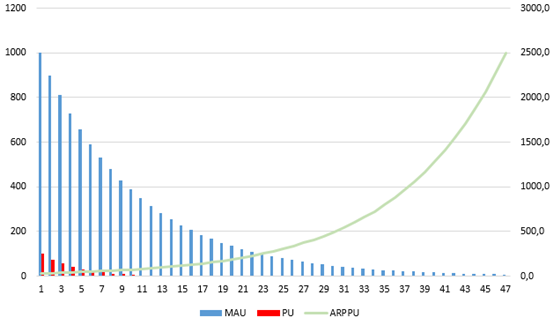Where to start when you undertake the creation of the game economy of a free-play game, – Konstantin Sakhnov, director of the game department of Rocket Jump studio, told on our pages.

Konstantin Sakhnov
In the classical sense, the economy of the game is a model of obtaining and spending resources. In this article we will look at how to approach the calculation of the game economy correctly — where to start and in which direction to move.
I will not tell you how to calculate the economy for a particular product or genre. I also won’t reveal any secret formulas that will give an absolute guarantee that your project will blow up the tops. The task of the text is different – to tell the reader how to approach the calculations in order to eventually get a working economic model that will help in the further development of the project.
The creation of the game economy is divided into two stages: the study of logic and numerical calculations. Without a well-thought-out logic, it is pointless to start calculations. There is a misconception among novice game designers that the game economy is primarily a bulky Excel spreadsheet with formulas and relationships. Tables are certainly needed, but they are not an end in themselves. This is just a tool, a way to implement the logical model on which the game will be built.
If you are making a game based in one way or another on limited resources (strategy, citybuilder, farm, and so on), the main goal of creating an economy is to ensure a shortage of in—game entities necessary for progress. In this case, the final result of the work will be the so-called deficit economy, which acts as a foundation for monetization.
If the developer does not plan to earn with the help of an internal economic system, then the task of the game designer is not to work with the business indicators of the game, but to balance the gameplay. We will talk about the balance in the next article, and now we will consider the work on the deficit economy.

Imperial: War of Tomorrow
Before you start working, you need to determine the boundary conditions. In the case of an economy focused on the profitability of the project, the key restrictions are dictated by the market. And this is the most important thing that you should understand. Calculations do not start with the assumptions of game designers and derived formulas, which are then adjusted to fit the desired result. Those who consider the game economy lucky, because all the necessary input data is already there.
If the game economy is to bring income to the project, you need to understand at what indicators it will pay off.
It is from this simple thesis that all further calculations follow. The payback of the product (like any investment in principle) is described by such an indicator as ROI (Return on Investment). In the classical form , it is calculated by the formula:
ROI = (Revenue – Costs) / Investment * 100%
In order for the product to be in the black, it is obviously necessary that the ROI exceeds 100%. Here is the first boundary condition for you.
In the situation with online games, especially mobile ones, the amount of investment is largely reduced to the cost of the traffic attracted to the project. In this case, ROI can be reduced to ROMI (Return of Marketing Investment). In the context of game advertising, the key expense item is the cost of purchased traffic. So, the ROI formula will look like this:
ROI = (LTV – CPI) / CPI
Here CPI (Cost Per Install) is the cost of one installation (roughly speaking, one attracted player), and LTV (Lifetime Value) is the income per user for all the time he spent in your game.
CPI depends more on the market, genre and setting of the game, rather than on in-game indicators. Approximate CPI values for your product can be obtained from traffic buyers. LTV primarily describes the ability of the product to offer the player an exciting gameplay and monetize it.

So, we have a condition — ROI > 100% — and we know the CPI. It is obvious that the ROI will not reach 100% immediately after the launch of the project (although miracles do happen). In the first month, the average player will spend a certain amount within the project. Let it be equivalent to 40% of the funds invested in its attraction (CPI). Realizing that the retention rate “washes out” the audience (some users will eventually “fall off” and leave the game), including the paying one, we can assume that this share will be less in the second and subsequent months. This means that with a 40% return on investment in the first 30 days, we will most likely need at least two more months for the total ROI of this user to exceed 100%.

Example: The Rolling ROI chart shows that it will take five months to return 100% of the investment.
As a result, when talking about fixing ROI, we set not one number, but a progression, which includes the month of reaching payback and the month of reaching the planned profit.
Our global goal in calculating an economy based on a shortage of resources is to understand what monetization depth needs to be laid in order to reach the profit necessary for payback. And here I will pay attention that this is not the amount that you need to get from the player. This soft clip is the depth of monetization — the amount of funds that a player can potentially invest in the game. It’s worth thinking about, because if you can invest only $ 10 in your project, then you will clearly not receive a profit from a player who is ready to spend $ 1000.

Let’s go back to the calculations. Knowing ROI and CPI, you can calculate LTV. It is necessary in order to understand what monetization depth should be laid in the economy in order to recoup the investments invested in the product. LTV consists of two indicators – how long a person has been playing, and how much money he spends on in-game goods on average. The final revenue can be increased by increasing any of these indicators. Let ‘s express this in the formula:
LTV = Lifetime * ARPDAU
We recall that Lifetime (the number of days spent in the game by the average player) is determined primarily by the retention rate of the project:
 In this case, the type of Retention function depends on which approach is chosen to the analysis of game indicators. It can be approximated with certain assumptions by a logarithm, hyperbola, or other decreasing function.
In this case, the type of Retention function depends on which approach is chosen to the analysis of game indicators. It can be approximated with certain assumptions by a logarithm, hyperbola, or other decreasing function.
What happens? We calculated the LTV of the project based on the ROI we needed. And now, knowing the estimated Retention values, we can calculate ARPDAU – the amount of money contributed to the game on average by one player per day of activity.
This is our goal – to understand how much money you need to earn from one player in order to recoup the investments invested in the project. In practice, when calculating the economy, it is more convenient for us to operate with such a value as ARPPU (average income per paying player per month). Let’s express it from ARPDAU.
First, let’s write out the formulas for ARPDAU and ARPU (average income per player):
ARPDAU = Daily Revenue / DAU
ARPU = Monthly Revenue / MAU
Here Daily Revenue and Monthly Revenue are the revenue of the game for the day and month, respectively. If we take 28 days in a month for convenience, then we will get:
Monthly Revenue / Daily Revenue = 28
Now let’s remember that the ratio of the daily active audience to the monthly one is called the Sticky Factor. This is an indicator of “stickiness” that characterizes user loyalty. Usually this indicator varies from 15% to 30%.
Sticky Factor = DAU / MAU
Then:
ARPU = ARPDAU * Sticky Factor * 28
Finally, we calculate ARPPU. This indicator should recoup the cost of traffic — roughly speaking, the profit from one player making purchases should exceed the cost of attracting dozens of non-paying ones. ARPPU can be calculated by dividing ARPU by PPU — the percentage of the paying audience from all project players.
ARPPU = ARPU / PPU
Now that you know the most important thing — what depth you need to put into the project — you can start counting the economy in numbers and formulas for a specific genre and a specific product. Despite the fact that all projects are different, finally I want to outline a few more theses that will help you in further calculations.
Calculation priorities
The further work of the game designer is directly calculations and their verification. Whatever the project, you can follow the following pattern, completing tasks in order of priority.
- Determine the scale of the currency in the economy by entering a coefficient linking real money, in-game currency and time.
- Write down all the game entities involved in the turnover, and identify all sources of input and output of resources.
- Establish the nature of resource changes in your economy, that is, the formulas of resource change dependencies. These can be power, exponential, or even recursive functions.
- Structure the player’s progress so that every day he has the opportunity to spend the amount of currency that will provide the necessary ARPU value.
- Think over and implement metrics into the game that will allow you to evaluate the correctness of the economic model you calculated after launch, as well as its relevance throughout the life of the project.
Attention to the main thing
As mentioned above, players, including those making purchases, eventually leave the project one way or another. The best games I worked on showed 85% monthly Retention of the paying audience with 10% Retention of all players. For us, this means that every next month it is necessary to increase the monetization potential in order to ensure the desired growth of the Rolling ROI of the cohort purchased by marketers with decreasing volumes of its audience.

The graph shows a drop in the share of the paying audience of one selected cohort (PU — Paying Users), which must be compensated by an increase in ARPPU.
Let’s be realistic — having put into the economy a monthly ROI growth of 40% for two years ahead, in practice we will not achieve such results. The calculation of the game economy of the clamp depends not only on our desires to have high ROI, but also on the real payment potential of the players.
Conclusions:
- The main goal of creating an in—game deficit economy is to provide monetization depth for traffic payback.
- Determine which ARPU will cover the investment.
- Think about the monetization potential — if a player wants to spend more in the project, he should have such an opportunity.
- Link the economy and gameplay carefully, especially if the project is tied to PvP.
